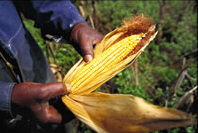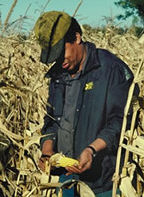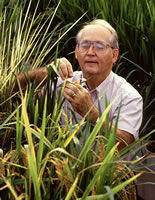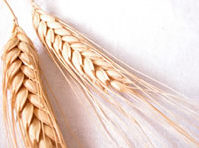Since the practice of agriculture began, eight to ten thousand years ago, farmers have been altering the genetic makeup of the crops they grow. Early farmers selected the best looking plants and seeds and saved them to plant for the next season. Then, once the science of genetics became better understood, plant breeders used what they knew about the genes of a plant to select for specific desirable traits to develop improved varieties.
The selection for features such as faster growth, higher yields, pest and disease resistance, larger seeds, or sweeter fruits has dramatically changed domesticated plant species compared to their wild relatives. For example, when corn was first grown in North and South America, thousands of years ago, the corn cobs farmers harvested were smaller than one’s little finger. Today, there are hundreds of varieties of corn, some of which produce cobs as long as one’s forearm.

Conventional plant breeding has been going on for hundreds of years, and is still commonly used today. Early farmers discovered that some crop plants could be artificially mated or cross-pollinated to increase yields. Desirable characteristics from different parent plants could also be combined in the offspring. When the science of plant breeding was further developed in the 20th century, plant breeders understood better how to select superior plants and breed them to create new and improved varieties of different crops. This has dramatically increased the productivity and quality of the plants we grow for food, feed and fiber.
The art of recognizing desirable traits and incorporating them into future generations is very important in plant breeding. Breeders scrutinize their fields and travel long distances in search of individual plants that exhibit desirable traits. A few of these traits occasionally arise spontaneously through a process called mutation, but the natural rate of mutation is very slow and unreliable to produce all the plant traits that breeders would like to see. (See box “Mutation Breeding”.)
Hybrid Seed Technology
The end result of plant breeding is either an open-pollinated (OP) variety or an F1 (first filial generation) hybrid variety. OP varieties, when maintained and produced properly, retain the same characteristics when multiplied. The only technique used with OP varieties is the selection of the seed-bearing plants.
Hybrid seeds are an improvement over open pollinated seeds in terms of qualities such as yield, resistance to pests and diseases, and time to maturity. Hybrid seeds are developed by the hybridization or crossing of parent lines that are ‘pure lines’ produced through inbreeding. Pure lines are plants that “breed true” or produce sexual offspring that closely resemble their parents. By crossing pure lines, a uniform population of F1 hybrid seed can be produced with predictable characteristics.
The simplest way to explain how to develop an F1 hybrid is to take an example. Let us say a plant breeder observes a particularly good habit in a plant, but with poor flower color, and in another plant of the same type he sees good color but poor habit. The best plant of each type is then taken and self-pollinated (in isolation) each year and, each year, the seed is re-sown. Eventually, every time the seed is sown the same identical plants will appear. When they do, this is known as a ‘pure line.’
If the breeder now takes the pure line of each of the two plants he originally selected and cross pollinates the two by hand the result is known as an “F1 hybrid.” Plants are grown from the seed produced, and the result of this cross pollination should have the combined traits of the two parents.
This is the simplest form of hybridization, but there are complications, of course. A completely pure line can sometimes take seven or eight years to achieve. Sometimes, a pure line is made up of several previous crossings to build in desirable features. The resulting plant is then grown on until it is genetically pure before use in hybridization.
In addition to qualities like good vigor, trueness to type, heavy yields and high uniformity which hybrid plants enjoy, other characteristics such as earliness, disease and insect resistance and good water holding ability have been incorporated into most F1 hybrids.
Unfortunately, these advantages come with a price. Because creating F1 hybrids involves many years of preparation to create pure lines that have to be constantly maintained so that F1 seeds can be harvested each year, the seeds then become more expensive. The problem is compounded because to ensure that no self-pollination takes place, all the hybridization of the two pure lines, sometimes, has to be done by hand.
Another disadvantage is if the seeds of the F1 hybrids are used for growing the next crops, the resulting plants do not perform as well as the F1 material - resulting in inferior yields and vigor. As a consequence, the farmer has to purchase new F1 seeds from the plant breeder each year. The farmer is, however, compensated by higher yields and better quality of the crop.
Though more expensive, hybrid seeds have had a tremendous impact on agricultural productivity. Today, nearly all corn and 50% of all rice are hybrids (DANIDA).
In the US, the widespread use of corn hybrids, coupled with improved cultural practices by farmers, has more than tripled corn grain yields over the past 50 years from an average of 35 bushels per acre in the 1930s to 115 bushels per acre in the 1990s. No other major crop anywhere in the world even comes close to equaling that sort of success story.
Hybrid rice technology helped China increase its rice production from 140 million tons in 1978 to 188 million tons in 1990. Research at the International Rice Research Institute (IRRI) and in other countries indicates that hybrid rice technology offers opportunities for increasing rice varietal yields by 15-20%. And this is achievable with the improved, semi-dwarf, and inbred varieties (IRRI).
Many cultivars of popular vegetables or ornamental plants are F1 hybrids. In terms of improved plant characteristics, tropical vegetable breeders can point to some rather clear achievements over the last two decades:
-
Yield improvement. Hybrids often outyield traditional OP selections by 50-100% due to its improved vigor, improved genetic disease resistance, improved fruit setting under stress, and higher female/male flower ratios.
-
Extended growing season. Hybrids often mature up to 15 days earlier than local OP varieties. For many crops, the hybrid’s relative advantage over the OP is most pronounced under stress conditions.
-
Quality improvement. Hybrids have helped stabilize product quality at a higher, and more uniform level – this implies improved consumption quality (e.g. firm flesh of wax gourd, crispy taste of watermelon).
Mutation Breeding
In the late 1920s, researchers discovered that they could greatly increase the number of these variations or mutations by exposing plants to X-rays and chemicals. “Mutation breeding” was further developed after World War II, when the techniques of the nuclear age became widely available. Plants were exposed to gamma rays, protons, neutrons, alpha particles, and beta particles to see if these would induce useful mutations. Chemicals, too, such as sodium azide and ethyl methanesulphonate, were used to cause mutations.
Mutation breeding efforts continue around the world today. Of the 2,252 officially released mutation breeding varieties, 1,019 or almost half have been released during the last 15 years. Examples of plants that have been produced via mutation breeding include wheat, barley, rice, potatoes, soybeans, and onions. (For FAOs’ Mutant Variety Database, visit http://www-mvd.iaea.org/MVD/default.htm.)
Conclusion
Conventional plant breeding resulting in open pollinated varieties (OP) or hybrid varieties has had a tremendous impact on agricultural productivity over the last decades. While an extremely important tool, conventional plant breeding also has its limitations. First, breeding can only be done between two plants that can sexually mate with each other. This limits the new traits that can be added to those that already exist in a particular species. Second, when plants are crossed, many traits are transferred along with the trait/s of interest - including those traits that have undesirable effects on yield potential.
References
-
Bauman, F. and Crane, P.L. 1992. Hybrid corn - History, development and selection considerations. National Corn Handbook. Purdue University, US.
-
DANIDA. 2002. Assessment of potentials and constraints for development and use of plant biotechnology in relation to plant breeding and crop production in developing countries. Working paper. Ministry of Foreign Affairs, Denmark.
-
East-West Seeds 1982-2002. 2002. Vegetable Breeding for Market Development. Edited by Karl Kunz. Bangkok, Thailand.
-
Food and Agriculture Organization. 2002. Crop Biotechnology: A working paper for administrators and policy makers in Sub-Saharan Africa.
-
-
-
Source










.jpg)